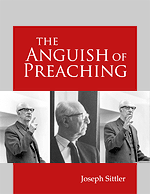|
This republication of The Anguish of
Preaching is made possible by The Joseph Sittler Archives
Committee, a collaborative ministry of the Evangelical Lutheran
Church in America and the Lutheran School of Theology at Chicago.
Download The Anguish of Preaching —
high resolution
 low resolution
low resolution
Foreword to The Anguish of Preaching
The original directives for the Dr. and Mrs. Jeremiah Zimmerman
Lectureship specify that the lecturer address himself
 to
some aspect of “effective preaching.” The latitude with which this
counsel has been interpreted over the years is itself a testimony to
the point the following chapters attempt to make: that the act of
preaching is so ecologically imbedded in the total reflection and
witness of the community that the sermon as a particular act cannot
be separated out for very useful discussion. to
some aspect of “effective preaching.” The latitude with which this
counsel has been interpreted over the years is itself a testimony to
the point the following chapters attempt to make: that the act of
preaching is so ecologically imbedded in the total reflection and
witness of the community that the sermon as a particular act cannot
be separated out for very useful discussion.
There is, to be sure, an act and a product
called the sermon. As such it is a fusion of exegesis and choices
involving aspect, accent, specific intention. And the sermon is also
a prose piece which imposes demands upon the literate writer. About
each of these activities of the mind that goes into the sermon many
helpful and acute things can be said.
But they have been said, over and over
again. Earlier lecturers in this series have spoken of the
difficulty, the joy, the required craftsmanship in the art of
preaching. So sensible, strong, clear, and true is much of that
material that to the sum of it I have not felt it necessary to add
anything at all. The effort that seemed to me possibly useful was to
reflect upon several immediate facts and issues troubling the
preacher right now, and out of such reflection to set down what I
hope may be both steadying to the battered seminarian in these
frenetic days and suggestive to him of how rich and various are the
intersections of scholarship, the arts, the shifts in language which
are formative of the moment in which he stands up to preach.
To choose to speak in that way is to
acknowledge that one shall very likely make no contribution to
theological scholarship. That fact must be swallowed, for what it
means to preach out of the swirling change in basic patterns of
thought and resolution that characterize our time is, I am
convinced, something no one knows very much about. The role of the
sermon in the transmission of tradition cannot be certainly
specified; all one can do is face facts, access the vitality of this
or that possibility, and probe for a way to preach that shall be as
appropriate as he can make it to his moment, his place, his people,
his own maturing toward conviction and clarity.
The section that deals with the form of
the church building is offered as the fourth chapter of this book
because what we are seeing and learning about life in our time in
architectural efforts is concrete data for the explication of the
preaching task. The architect is not a preacher; but he, too,
struggles to find forms effective for the announcement of a
tradition — momentum; and the components of his effort have their
counterpart in the conceptual and verbal struggle of the preacher.
It is a happy duty to record here my
thanks to the President and Faculty of the Lutheran Theological
Seminary at Gettysburg, Pennsylvania, for the occasion to prepare
these lectures and to recall with pleasure the courtesy with which
they were received.
Joseph Sittler
Chicago, September, 1966
|